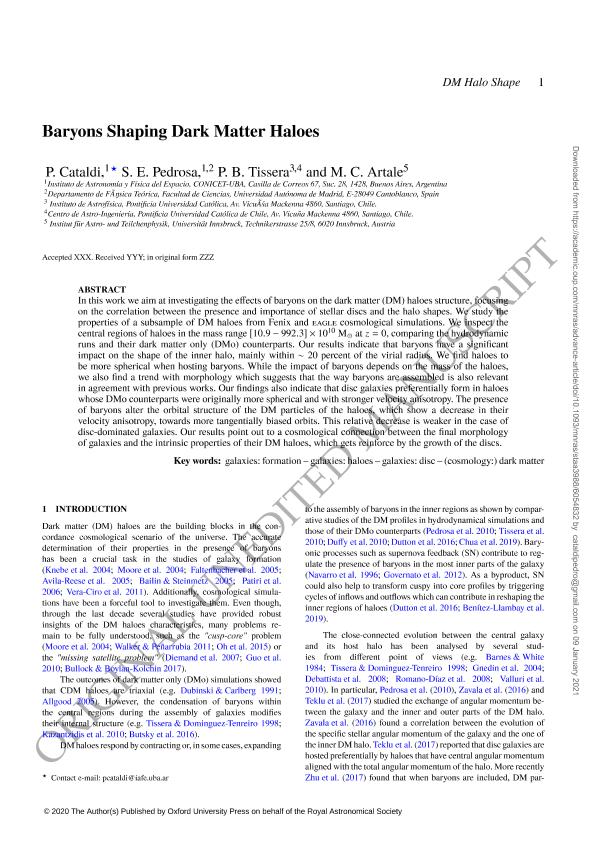Mostrar el registro sencillo del ítem
dc.contributor.author
Cataldi, Pedro Anselmo

dc.contributor.author
Pedrosa, Susana Elizabeth

dc.contributor.author
Tissera, Patricia Beatriz

dc.contributor.author
Artale, Maria Celeste

dc.date.available
2022-02-25T04:28:10Z
dc.date.issued
2020-12
dc.identifier.citation
Cataldi, Pedro Anselmo; Pedrosa, Susana Elizabeth; Tissera, Patricia Beatriz; Artale, Maria Celeste; Baryons Shaping Dark Matter Haloes; Wiley Blackwell Publishing, Inc; Monthly Notices of the Royal Astronomical Society; 501; 4; 12-2020; 1-13
dc.identifier.issn
0035-8711
dc.identifier.uri
http://hdl.handle.net/11336/152721
dc.description.abstract
In this work we aim at investigating the effects of baryons on the dark matter (DM) haloes structure, focusing on the correlation between the presence and importance of stellar discs and the halo shapes. We study the properties of a subsample of DM haloes from Fenix and eagle cosmological simulations. We inspect the central regions of haloes in the mass range [10.9 − 992.3] × 1010 M at z = 0, comparing the hydrodynamic runs and their dark matter only (DMo) counterparts. Our results indicate that baryons have a significant impact on the shape of the inner halo, mainly within ∼ 20 percent of the virial radius. We find haloes to be more spherical when hosting baryons. While the impact of baryons depends on the mass of the haloes, we also find a trend with morphology which suggests that the way baryons are assembled is also relevant in agreement with previous works. Our findings also indicate that disc galaxies preferentially form in haloes whose DMo counterparts were originally more spherical and with stronger velocity anisotropy. The presence of baryons alter the orbital structure of the DM particles of the haloes, which show a decrease in their velocity anisotropy, towards more tangentially biased orbits. This relative decrease is weaker in the case of disc-dominated galaxies. Our results point out to a cosmological connection between the final morphology of galaxies and the intrinsic properties of their DM haloes, which gets reinforce by the growth of the discs.
dc.format
application/pdf
dc.language.iso
eng
dc.publisher
Wiley Blackwell Publishing, Inc

dc.rights
info:eu-repo/semantics/openAccess
dc.rights.uri
https://creativecommons.org/licenses/by-nc-sa/2.5/ar/
dc.subject
galaxies: formation
dc.subject
galaxies: haloes
dc.subject
galaxies: disc
dc.subject
(cosmology:) dark matter
dc.subject.classification
Astronomía

dc.subject.classification
Ciencias Físicas

dc.subject.classification
CIENCIAS NATURALES Y EXACTAS

dc.title
Baryons Shaping Dark Matter Haloes
dc.type
info:eu-repo/semantics/article
dc.type
info:ar-repo/semantics/artículo
dc.type
info:eu-repo/semantics/publishedVersion
dc.date.updated
2021-03-15T15:47:52Z
dc.journal.volume
501
dc.journal.number
4
dc.journal.pagination
1-13
dc.journal.pais
Reino Unido

dc.description.fil
Fil: Cataldi, Pedro Anselmo. Consejo Nacional de Investigaciones Científicas y Técnicas. Oficina de Coordinación Administrativa Ciudad Universitaria. Instituto de Astronomía y Física del Espacio. - Universidad de Buenos Aires. Facultad de Ciencias Exactas y Naturales. Instituto de Astronomía y Física del Espacio; Argentina
dc.description.fil
Fil: Pedrosa, Susana Elizabeth. Universidad Autónoma de Madrid. Facultad de Ciencias; España. Consejo Nacional de Investigaciones Científicas y Técnicas. Oficina de Coordinación Administrativa Ciudad Universitaria. Instituto de Astronomía y Física del Espacio. - Universidad de Buenos Aires. Facultad de Ciencias Exactas y Naturales. Instituto de Astronomía y Física del Espacio; Argentina
dc.description.fil
Fil: Tissera, Patricia Beatriz. Pontificia Universidad Católica de Chile; Chile. Consejo Nacional de Investigaciones Científicas y Técnicas. Oficina de Coordinación Administrativa Ciudad Universitaria. Instituto de Astronomía y Física del Espacio. - Universidad de Buenos Aires. Facultad de Ciencias Exactas y Naturales. Instituto de Astronomía y Física del Espacio; Argentina
dc.description.fil
Fil: Artale, Maria Celeste. Universidad de Innsbruck; Austria. Consejo Nacional de Investigaciones Científicas y Técnicas. Oficina de Coordinación Administrativa Ciudad Universitaria. Instituto de Astronomía y Física del Espacio. - Universidad de Buenos Aires. Facultad de Ciencias Exactas y Naturales. Instituto de Astronomía y Física del Espacio; Argentina
dc.journal.title
Monthly Notices of the Royal Astronomical Society

dc.relation.alternativeid
info:eu-repo/semantics/altIdentifier/url/https://academic.oup.com/mnras/advance-article/doi/10.1093/mnras/staa3988/6054832
dc.relation.alternativeid
info:eu-repo/semantics/altIdentifier/doi/http://dx.doi.org/10.1093/mnras/staa3988
Archivos asociados
